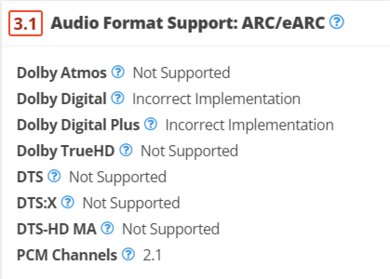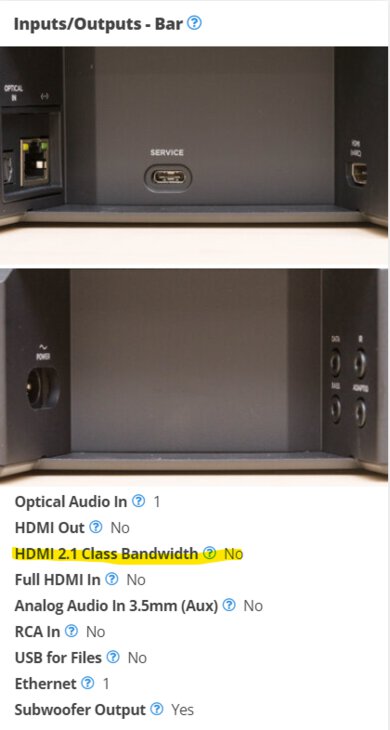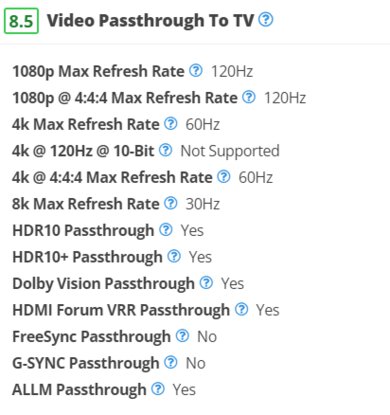Check out our latest 1.3 changelog.
Goal
Our Test Bench 1.2 update tackles a few key issues. If you plan to connect your soundbar to devices like a Blu-ray player, you'll want to ensure that it supports immersive audio formats such as surround sound. While we tested for audio format support in our previous 1.1 Test Bench, we wanted to incorporate a simpler and more robust methodology to eliminate the risk of error. Also, you've asked us to improve our evaluations by testing for support for an expanding list of features like HDMI 2.1, variable refresh rates, and HDR features like Dolby Vision, HDR10, and HDR10+, which are relevant when using your bar for video passthrough between devices like your TV and your gaming console.
This is the second in a series of planned soundbar test bench updates, and in the coming months, we'll address some of our sound testing, as well as latency.
Summary of Changes
Click on the links in the table below to learn more about these changes.
| Test Group | Change |
|---|---|
|
Audio Format Support |
|
|
Inputs/Outputs - Bar |
|
|
Video Passthrough to TV |
|
Issues with our Test
You asked us to improve our methodology for these results to make our results more reliable, and we listened.
Simply put, our audio format support tests are designed to confirm whether a bar supports certain audio formats. Seems easy enough, right? As it turns out, it's much more complicated than that. Part of what makes formats like Dolby Digital or Dolby Atmos sound so immersive is that they're designed to send specific effects to specific channels—so, for example, if a car races past on the left in a chase scene, you hear those sounds from the left side of your living room. Some bars downmix this content, though, so while you still hear some sound from the bar, some effects aren't reproduced as intended.
To better understand the problem, let's look at an example. We wanted to understand whether the Samsung HW-Q950A supports 5.1 LPCM content. After all, when you play this format on the bar, you hear sound. However, thanks to user feedback, we identified that this wasn't correct. This bar played sound, but the effects intended for the satellites were only played back through the left and right surround channels on the bar. This resulted in a less clear and real feel—so it didn't feel like your audio was happening all around you. You had to switch to other preset modes like Game, Surround, or Adaptive Sound to hear audio from the satellites as intended, but in these cases, we couldn't identify whether it was a true 5.1 PCM, or if the bar fell back to 2.1 PCM, then upmixed it. This issue was eventually fixed with a firmware update, but at the time, our methodology struggled in identifying a clear answer.
Over the years, we made some adjustments to our methodology to improve the reliability of our results. For example, when testing over ARC, we use a Murideo Seven Generator to verify that each channel plays back sound as it should. With PCM content, the Murideo uses a voice to "call out" each of the channels, one after the other, to confirm that sound comes from that channel and only that channel. You can see an example in the video below.
Our Changes
So, how did we fix the problem?
To better identify issues with audio format support, we wanted to use callback tests similar to those available through the Murideo when testing PCM content.
Moving forward, we'll use a Blu-ray player to test audio format support, with a range of Dolby and DTS test files that confirm each channel performs as expected and to identify any issues like when channels are dropped or not correctly placed. We'll test over ARC, HDMI In, and Optical, when available.
In our old reviews, our Audio Format Support results came down to one of two options: "Yes" or "No". However, certain bars didn't fit into this binary model very well—take the onn. 42" 5.1.2 Dolby Atmos Soundbar, for example. When you listen to Dolby Digital content, effects meant specifically for either the left or right surround channels play out of both sides simultaneously. The same issue occurs with Dolby Digital Plus and Dolby TrueHD.
Moving forward, we'll use a middle-ground option for bars like the onn. 42" 5.1.2 Dolby Atmos Soundbar—"Incorrect Implementation." In these instances, where channels aren't correctly placed, you notice a less accurate localization of sound effects in the space around you. For example, an explosion on the right side of the screen seems like it's coming from a more general area in front of you rather than a more exact location that matches the action on the screen.

You can also sort through our audio format support results using our table tool.
Inputs/Outputs - Bar - Test Added
For this section of our test bench update, we wanted to check for full HDMI 2.1 bandwidth support by confirming support of a 4k @ 120Hz @ 10-bit signal, which is higher than the bandwidth available on HDMI 2.0. We've received a lot of user feedback, and we're aware that this information is really important to you when buying your next soundbar, especially if you're interested in gaming. Higher refresh rates are handy for reducing motion blur, and many consoles like the PS5 and Xbox Series X are designed for compatibility with 120 frame-per-second signals.
We've added a new HDMI 2.1 Class Bandwidth test to our soundbar reviews, and you can see the results in the Inputs/Outputs box. Plus, you can now quickly sort through our reviews to see which soundbars have it.

Video Passthrough To TV - Tests Added

That said, changes in HDMI licensing have led to some confusion about what exactly HDMI 2.1 supports with particular TVs and soundbars. As a result, we've decided to add some new tests to verify what's truly available—you can even sort through our test results in this table here.
In most cases, you'll connect your soundbar to your TV, so we focused our coverage on the most common TV resolutions and the most common TV refresh rates. For example, 4k content is often found on Ultra HD Blu-rays as well as different streaming services. High Dynamic Range (HDR) technologies, including HDR10, HDR10+, and Dolby Vision, which are designed to enhance the picture quality compared to regular content, are more and more common with streaming services and Blu-rays, too. In fact, as of October 2022, Apple supports HDR10+ through the Apple TV+ app, and they've updated their HDR content with HDR10+ metadata. You can learn more about where to find this content here, as well as through some examples in the table below.
| HDR10 | HDR10+ | Dolby Vision | |
|---|---|---|---|
| PS4/PS4 Pro | Yes | No | No |
| PS5 | Yes | No | No |
| Xbox One | Yes | No | Yes |
| Xbox Series X/S | Yes | No | Yes |
| Nintendo Switch | No | No | No |
| PC | Yes | Yes | Yes |
| Apple TV 4k 3rd Gen | Yes | Yes | Yes |
For gamers, it's also worth investigating whether your soundbar can passthrough variable refresh rate (VRR) technology. These are designed to ensure a smooth, tear-free gaming experience by synching up your TV's refresh rate with your gaming console's output. It's especially helpful if you play a lot of fast-motion games, like those with first-person shooters. It helps to ensure smooth gameplay without screen tearing at changing refresh rates.
VRR is included in the new HDMI 2.1 standard, as it's included with newer consoles like Xbox Series X/S and PS5. Since the standard is relatively new, there are also some other technologies out there, like NVIDIA's G-SYNC and AMD's FreeSync. You can see examples of how this all plays out in the table below.
| HDMI Forum | FreeSync | G-SYNC | |
|---|---|---|---|
| PS4/PS4 Pro | No | No | No |
| PS5 | Yes | No | No |
| Xbox One | Yes | Yes | No |
| Xbox Series X/S | Yes | Yes | No |
| NVIDIA RTX 3000 series | Yes | No | Yes |
| NVIDIA RTX 2000 series | Yes | No | Yes |
| NVIDIA GTX 1000 series | No | No | Yes |
| AMD Radeon RX 6000 series | Yes | Yes | No |
| AMD Radeon RX 5000 series | Yes | Yes | No |
| AMD Radeon RX 500 series | No | Yes | No |
It's pretty uncommon to use a soundbar at your desk with your monitor. Therefore, resolution and refresh rates common to monitors aren't currently part of our test bench. We also chose not to include 144Hz since so few TVs support it reliably at this time. We'll keep an eye on your feedback, of course, and if there's a lot of interest from the community, we'll consider adding these as part of a future test bench update. For gamers, it's also worth noting that we have plans to update our latency testing in the coming months, too.
So, what do you think? Did we miss anything? We're always interested in hearing your feedback, so as always if you have any comments on these latest changes, don't hesitate to let us know in our forums.
71 Soundbars Updated
We have retested popular models. The test results for the following models have been converted to the new testing methodology. However, the text might be inconsistent with the new results.
- Bose Smart Soundbar 300
- Bose Smart Soundbar 600
- Bose Smart Soundbar 700
- Bose Smart Soundbar 700 with Speakers + Bass Module
- Bose Smart Soundbar 900
- Bose Smart Soundbar 900 with Speakers + Bass Module
- Bose Solo 5
- Bose Solo Soundbar Series II
- Bose TV Speaker
- JBL Bar 1000
- JBL Bar 5.1 Surround
- JBL Bar 9.1
- Klipsch Cinema 1200
- Klipsch Cinema 800
- LG Eclair QP5
- LG S65Q
- LG S75Q
- LG S80QY
- LG S90QY
- LG S90QY with SPQ8-S Speaker Kit
- LG S95QR
- LG SC9S
- LG SP7Y
- LG SP8YA
- Nakamichi Shockwafe Ultra 9.2 eARC
- onn. 42" 5.1. 2. Dolby Atmos Soundbar
- Polk Audio MagniFi MAX SR
- Polk Audio Signa S4
- Samsung HW-B450
- Samsung HW-B550
- Samsung HW-B650
- Samsung HW-Q600A
- Samsung HW-Q600B
- Samsung HW-Q60B
- Samsung HW-Q65T
- Samsung HW-Q67CB
- Samsung HW-Q800B
- Samsung HW-Q910B
- Samsung HW-Q930B
- Samsung HW-Q950A
- Samsung HW-Q990B
- Samsung HW-S60B
- Samsung HW-S800B
- Sennheiser AMBEO Soundbar MAX
- Sennheiser AMBEO Soundbar Plus
- Sonos Arc
- Sonos Arc with Sub + One SL Speakers
- Sonos Beam
- Sonos Beam (Gen 2)
- Sonos Beam (Gen 2) with Sub Mini + One SL Speakers
- Sony HT-A3000
- Sony HT-A5000
- Sony HT-A7000
- Sony HT-A7000 with Speakers + Bass Module
- Sony HT-A9
- Sony HT-G700
- Sony HT-S100F
- Sony HT-S400
- Sony HT-X8500
- TCL Alto 6+
- TCL Alto 8+
- Vizio Elevate
- Vizio M Series Elevate M512E-K6
- Vizio M Series M213ad-K8
- Vizio M Series M512a-H6
- Vizio M Series M51a-H6
- Vizio M Series M51ax-J6
- Vizio SB36512-F6
- Vizio V Series V21-H8
- Vizio V Series V51-H6
- Vizio V Series V51x-J6